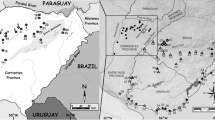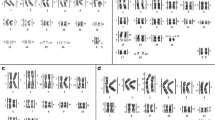Abstract
Banding sequences of five chromosomal arms (A, C, D, E, and F), accounting for about 70% of the total genome size in 63 Chironomus species, were used as markers to analyze divergence patterns of the linear genome structure during the evolution. The number of chromosomal breakpoints between the pairs of banding sequences compared served as a measure of divergence. It was demonstrated that the greater the divergence between the species compared, the higher the number of chromosomal breakpoints and the smaller the size of the conserved chromosomal segments. A banding sequences comparison in sibling species demonstrated a lower number of chromosomal breakpoints; the breakpoint number was maximum in a comparison of the banding sequences in the subgenera Chironomus and Camptochironomus. The use of the number of chromosomal breakpoints as a genome divergence measure provided establishment of phylogenetic relationships between 63 Chironomus species and discrimination of sibling species groups and cytocomplexes on a phylogenetic tree.
Similar content being viewed by others
REFERENCES
Nadeau, J.H. and Taylor, B.A., Length of Chromosomal Segments Conserved Since Divergence of Man and Mouse, Proc. Natl. Acad. Sci. USA, 1984, vol. 81, pp. 814–818.
Zakharov, I.A., Nikiforov, V.S., and Stepanyuk, E.V., Measuring Similarity in the Order of Homologous Genes, Genetika (Moscow), 1991, vol. 27, no.2, pp. 367–369.
Zakharov, I.A., Nikiforov, V.S., and Stepanyuk, E.V., Homology and Evolution of Gene Orders: Simulation and Reconstruction of the Evolutionary Process, Rus. J.Genet., 1997, vol. 33, no.1, pp. 24–30.
Sankoff, D. and Nadeau, J.H., Conserved Synteny As a Measure of Genomic Distance, Discrete Appl. Math., 1996, vol. 71, pp. 247–257.
Segarra, C. and Aguade, M., Molecular Organization of the X Chromosome in Different Species of the obscura Group of Drosophila, Genetics, 1992, vol. 130, pp. 513–521.
Segarra, C., Lozovskaya, E.R., Ribo, G., et al., P1 Clones from Drosophila melanogaster As Markers to Study the Chromosomal Evolution of Muller’s A Element in Two Species of obscura Group of Drosophila, Chromosoma, 1995, vol. 104, pp. 129–136.
Gonzales, J., Ranz, J.M., and Ruiz, A., Chromosome Elements Evolve at Different Rates in the Drosophila Genome, Genetics, 2002, vol. 161, pp. 1137–1154.
Keyl, H.-G., Chromosomenevolution bei Chironomus: II. Chromosomenumbauten und phylogenetische Beziehungen der Arten, Chromosoma, 1962, vol. 13, pp. 464–514.
Martin, J., Wuelker, W., and Sublette, J.E., Evolutionary Cytology in the Genus Chironomus Meig, Stud. Nat. Sci., 1974, vol. 1, pp. 1–12.
Martin, J., Chromosomes As Tools in Taxonomy and Phylogeny of Chironomidae (Diptera), Entomol. Scand., 1979, vol. 10,suppl., pp. 67–74.
Wuelker, W., Basic Patterns in the Chromosome Evolution of the Genus Chironomus (Diptera), Z. Zool. Syst. Evol., 1980, vol. 18, pp. 112–123.
Kiknadze, I.I., Shilova, A.I., Kerkis, I.E., et al., Kariotip i morfologiya lichinok triby Chironomini. Atlas (Karyotype and Morphology of Larvae of the Tribe Chironomini: An Atlas), Novosibirsk, 1991.
Kiknadze, I.I., Istomina, A.G., Gunderina, L.I., et al., Kariofondy khironomid kriolitozony Yakutii. Triba Chironomini (Karyopools of Chironomidae of the Yakutian Cryolithozone: Tribe Chironomini), Novosibirsk, 1996.
Wuelker, W., Dévai, G., and Dévai, I., Computer-Assisted Studies of Chromosome Evolution in the Genus Chironomus (Dipt.): Comparative and Integrated Analysis of Chromosome Arms A, E, and F, Acta Biol. Debr. Oecol. Hung., 1989, vol. 2, pp. 373–387.
Shobanov, N.A. and Zotov, S.A., Cytogenetic Aspects of Phylogeny of the Genus Chironomus Meigen (Diptera, Chironomidae), Entomol. Obozr., 2001, vol. 80, no.1, pp. 180–192.
Shobanov, N.A., Evolution of the Genus Chironomus (Dirtera, Chironomidae): 2. A Phylogenetic Model, Zool. Zh., 2002, vol. 81, no.6, pp. 711–718.
Scholl, A., Geiger, H.J., and Ryser, H.M., Die Evolution der Gattung Chironomus aus Biochemisch-Genetischer Sicht, in Chironomidae: Ecology, Systematics, Cytology and Physiology, Oxford: Pergamon, 1980, pp. 25–33.
Filippova, M.A., Gunderina, L.I., and Kiknadze, I.I., A Population-Genetic Study of the Species of the Chironomus Genus (Diptera: Chironomidae), Acta. Biol. Debr. Oecol. Hung., 1989, vol. 2, pp. 195–206.
Guriev, V., Makarevitch, I., Blinov, A., and Martin, J., Phylogeny of the Genus Chironomus (Diptera) Inferred from Sequences Mitochondrial Cytochrome b and Cytochrome Oxidase 1, Mol. Phylogenet. Evol., 2001, vol. 19, no.1, pp. 9–21.
Devai, G., Miskolczi, M., and Wuelker, W., Standardization of Chromosome Arms B, C, and D in Chironomus (Diptera, Chironomidae), Acta Biol. Debr. Oecol. Hung., 1989, vol. 2, pp. 79–92.
Kiknadze, I.I., Golygina, V.V., Istomina, A.G., and Gunderina, L.I., Pattern of Chromosome Polymorphism during Population and Species Divergence in Chironomis (Diptera, Chironomidae), Sib. Ekol. Zh., 2004, vol. 11, no.5, pp. 635–651.
Gunderina, L.I., Kiknadze, I.I., and Golygina, V.V., Intraspecific Differentiation of the Cytogenetic Structure in Natural Populations of Chironomus plumosus L., the Central Species in the Group of Sibling Species, Rus. J.Genet., 1999, vol. 35, no.2, pp. 142–150.
Golygina, V.V. and Kiknadze, I.I., The Karyofund of Chironomus plumosus (Diptera, Chironomidae) in Pale-arctic, Tsitologiya, 2001, vol. 43, pp. 507–519.
Gusev, V.D., Nemytikova, L.A., and Chuzhanova, N.A., Rapid Method for Identification of Interconnections between Functionally and/or Evolutionarily Related Biological Texts, Mol. Biol. (Moscow), 2001, vol. 35, no.6, pp. 1015–1022.
Kiknadze, I.I., Gunderina, L.I., Istomina, A.G., et al., Similarity Analysis of Inversion Banding Sequences of Chironomus Species (Breakpoint Phylogeny), in Bioinformatics of Genome Regulation and Structure, Boston, 2003, pp. 245–253.
Saitou, N. and Nei, M., The Neighbour-Joining Method: A New Method for Reconstructing Phylogenetic Trees, Mol. Biol. Evol., 1987, vol. 4, pp. 406–425.
Kumar, S., Tamura, K., Jakobsen, I.B., and Nei, M., MEGA2: Molecular Evolutionary Genetic Analysis Software, Tempe, Arizona: Arizona State Univ., 2001.
Lakin, G.F., Biometriya (Biometrics), Moscow: Vysshaya Shkola, 1980.
Kiknadze, I.I., Blinov, A.G., and Kolesnikov, N.N., Molecular Cytological Organization of the Genome in Chironomidae, in Strukturno-funktsional’naya organizatsiya genoma (Structural and Functional Organization of the Genome), Novosibirsk: Nauka, 1989, pp. 4–58.
Eggleston, W.B., Rim, N.R., and Lim, J.K., Molecular Characterization of the hobo-Mediated Inversions in Drosophila melanogaster, Genetica, 1996, vol. 144, pp. 647–656.
Andolfatto, P., Wall, J.D., and Kreitman, M., Unusual Haplotype Structure at the Proximal Breakpoint of the In(2L)t in a Natural Population of Drosophila melanogaster, Genetics, 1999, vol. 153, pp. 1297–1311.
Cáceres, M., Ranz, J.M., Barbadilla, A., et al., Generation of a Widespread Drosophila Inversion by a Transposable Element, Science, 1999, vol. 285, pp. 415–418.
Evgen’ev, M.B., Zelentsova, H., Poluectova, H., et al., Mobile Elements and Chromosomal Evolution in virilis Group of Drosophila, Proc. Natl. Acad. Sci. USA, 2000, vol. 97, pp. 11 337–11 342.
Casals, F., Caceres, M., and Ruiz, A., The Foldback-Like Transposon Galileo Is Involved in the Generation of Two Different Natural Chromosomal Inversions of Drosophila buzzatii, Mol. Biol. Evol., 2003, vol. 20, pp. 675–685.
Lyttle, T.W. and Haymer, D.S., The Role of Transposable Element hobo in the Origin of Endemic Inversions in Wild Populations of Drosophila melanogaster, Genetics, 1992, vol. 86, pp. 113–126.
Wesley, C.S. and Eanes, W.F., Isolation and the Analysis of the Breakpoint Sequences of Chromosome Inversion In(3L)Payne in Drosophila melanogaster, Proc. Natl. Acad. Sci. USA, 1994, vol. 91, pp. 3132–3136.
Cirera, S., Martin-Campos, J., Segarra, C., and Aguade, M., Molecular Characterization of the Breakpoints of an Inversion Fixed between Drosophila melanogaster and D. subobscura, Genetics, 1995, vol. 139, pp. 321–326.
Rozas, J., Segarra, C., Riby, C., and Aguade, M., Molecular Population Genetics of the rp49 Gene Region in Different Chromosomal Inversions of Drosophila sub-obscura, Genetics, 1999, vol. 151, pp. 189–202.
Author information
Authors and Affiliations
Additional information
Translated from Genetika, Vol. 41, No. 2, 2005, pp. 187–195.
Original Russian Text Copyright © 2005 by Gunderina, Kiknadze, Istomina, Gusev, Miroshnichenko.
Rights and permissions
About this article
Cite this article
Gunderina, L.I., Kiknadze, I.I., Istomina, A.G. et al. Divergence of the polytene chromosome banding sequences as a reflection of evolutionary rearrangements of the genome linear structure. Russ J Genet 41, 130–137 (2005). https://doi.org/10.1007/s11177-005-0036-6
Received:
Issue Date:
DOI: https://doi.org/10.1007/s11177-005-0036-6




